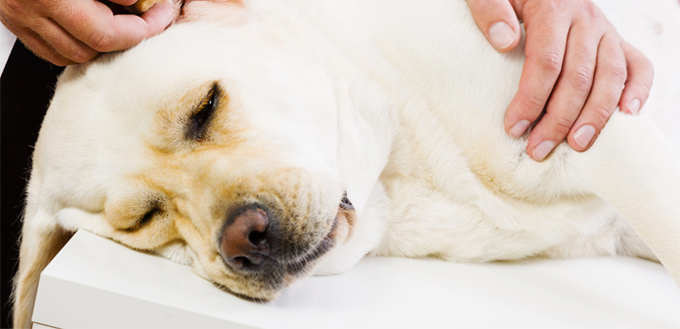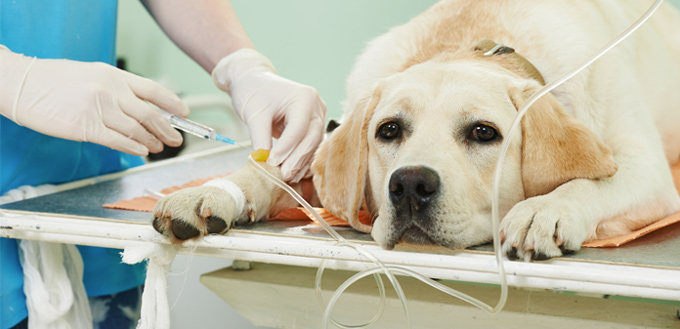About 1 in 5 skin tumors found in dogs are classified as mast cell tumors, commonly known as mastocytoma. Veterinary cancer specialists or oncologists call mastocytoma as the ‘great pretender’ primarily because of its highly varied appearance that can range anywhere from a soft lump felt underneath the dog’s skin to a nodule that looks more like a wart. In some cases, they look like small masses with ulcerations on your dog’s skin. While the cancer cells start on or near the skin, these can easily spread to other organs especially the liver, spleen, and bone marrow, producing more problems for the dog.
What is Mastocytoma in Dogs?
Mastocytoma or mast cell tumor is defined as the abnormal growth and proliferation of mutant mast cells that are found in numerous connective tissues all over the dog’s body. These connective tissues where mast cells reside are generally found on nerves and blood vessels that lie close to external surfaces such as the skin, nose, lungs, and mouth.
Mast cells are important when it comes to defending your dog against parasitic infections as well as in the repair of damaged tissues. Mast cells are also important in the building of new blood vessels, a process called angiogenesis. Perhaps one of the most clinically significant roles of mast cells is its ability to release pro-inflammatory substances like histamine that mediate immune reactions, specifically allergic reactions. It is this function that many of the symptoms associated with mastocytoma have their origins.

Like all types of cancers, mast cell tumors are graded according to a variety of factors. These include the presence of inflammation, the tumor’s location in the dog’s skin, and how well the tumor cells have differentiated.
- Grade 1 mast cell tumors have low metastatic potential, generally described as well-differentiated, and typically originate from the skin.
- Grade 2 cells, on the other hand, have the potential to invade or metastasize to neighboring tissues. These have intermediate differentiation and are mostly found in the subcutaneous layer of the skin.
- Grade 3 mast cell tumor cells have a very high chance of traveling or metastasizing to other, more distant body parts such as the liver, spleen, and even the bone marrow. They are also poorly differentiated and are typically located in deeper areas below the dog’s skin.
When we talk about cellular differentiation, we are talking about a tumor cell’s resemblance to a normal cell. Hence, a poorly-differentiated cell means it looks nothing like the normal cell and is generally considered to be a sign of the severity and extent of the tumor.
What Causes Mastocytoma in Dogs?
The exact cause of mastocytoma in dogs remains a mystery, although the current observation is that certain breeds of dogs such as Boston terriers, Labrador Retrievers, Boxers, Pugs, Beagles, Schnauzers, and Bulldogs seem to be more vulnerable to the formation of mast cell tumors. It has also been observed that cancer typically manifests on middle adult dogs with a median age of 8 years, although there have been cases where younger hounds no older than 1 year of age have been diagnosed with mastocytoma. The disease is also more common among mixed breeds of dogs.
One very interesting observation is that mastocytoma is quite common with chronic inflammation as well as the chronic application of a variety of irritants onto the skin of founds. Studies have hinted on the possibility of chromosomal fragility as the direct cause of the changes in mast cell morphology. What causes chromosomal fragility to be expressed is unknown, however.
Other theories about what causes mastocytoma in dogs include the following.
- Changes in p23 tumor suppression pathway
- Problems in the expression of cyclin-dependent kinase, p21, and p27 protein kinase inhibitors
- The expression of a tyrosine kinase receptor (c-Kit)
- Mutations occurring at the c-Kit’s juxtamembrane
- Issues in estrogen and progesterone synthesis
Until science can be certain as to what exactly causes mastocytoma in dogs, it is safe to assume that it always starts with changes in the structure of the mast cell. This is where skin irritants can come into play.
How Do I Know If My Dog Has Mastocytoma?
Veterinary oncologists call mast cell tumors as ‘great pretenders’ since they can look like very ordinary skin lesions in dogs. While it may be difficult to determine with absolute certainty just by looking at these lesions alone that your dog has mastocytoma, it is somehow possible to have a sense that your pet has one.
For instance, the presence of a solid mass on your dog’s skin or even felt under its skin that has been there for many days or even many months and may appear to grow or fluctuate in size is almost always an indication of a tumor. If this solid mass seems not to grow and then all of a sudden grows very fast in a span of a few days to a few weeks, you’re almost as certain that you have a skin tumor in your dog.

The lesions on your dog’s skin may look like an ordinary lump resembling lipoma. In some cases, you may even see something like a wart-like nodule. If not, you may see ulcerated lumps or even thick masses complete with focal thickenings or stalks. These often change in size rather quickly because of the reactions occurring within and around the mass.
The presence of Darier’s sign which is localized swelling and redness especially when the solid mass is scratched or manipulated by your dog is also indicative of mast cell tumor. This can be accompanied by localized hemorrhaging under its skin. There can also be enlarged lymph nodes as well as intense itching especially around the lesions.
The lesions can be found as a single mass or can be scattered throughout your dog’s body, although more than half of all mastocytoma cases present with lesions localized on the dog’s trunk as well as perineum. Only 10 percent of these lesions are found on the head and neck areas of your dog while the remaining 40 percent covers your pet’s limbs, especially its paws.
If a Grade 3 mast cell tumor is suspected, your dog may have loss of appetite, anemia, diarrhea, and vomiting. These are often the result of ulceration in the dog’s duodenum and stomach because of the increased secretion of histamine. These can also be brought about by disseminated intravascular coagulation because of the increased release of heparin by the diseased mast cells.
The severity of the clinical manifestations of mastocytoma actually depends on the current staging of the disease. The lower the stage, the less severe the manifestations.
In Stage 1 only a single tumor may be seen. Stage 2 is characterized by possible metastasis to neighboring lymph nodes although there is still just a single tumor. In Stage 3, multiple tumors are evident and have already begun to invade the subcutaneous tissues of the skin. In Stage 4, there is already the involvement of other organs which can lead to the systemic manifestations seen in mastocytoma in dogs.
How Is It Diagnosed?
Diagnosing mastocytoma in dogs based on history alone is difficult. While your dog’s health history, as well as the history of its symptoms, may give your vet clues to the possibility of the disease, know that mastocytoma accounts only for about a fifth of all types of skin cancers in dogs, not including those that are caused by allergic reactions of non-cancerous origin.
The most definitive way to ascertain the presence of mastocytoma in dogs is by performing a biopsy and examining the sample under microscope. Needle aspiration biopsy will show a substantially large number of mast cells and is sufficient diagnostic indicator of mastocytoma.
However, to determine the grade of the tumor cell, surgical biopsy is needed. The tissue sample is examined for the degree of cell differentiation, level of mitotic activity, its location relative to the skin, and the degree of its invasiveness. Surgical biopsy may also help determine the presence of inflammation especially in the surrounding tissues or even possibly tissue death or necrosis.
When it comes to staging of mastocytoma, specific organ biopsies may have to be performed often in addition with ultrasound and X-ray tests. Tissue samples from the lymph nodes, liver, spleen, and bone marrow may have to be obtained to determine if the mastocytoma has already spread towards these organs.
What Treatments Are Available?
There are essentially two goals of treatment for dogs that are diagnosed with mastocytoma. These include the removal of the tumor and the management of associated symptoms.
In the removal of the tumor, there are two treatment options available, although it is not uncommon to see veterinarians employing both for maximum therapeutic effects.
Surgical excision is preferred in Stage 1 and 2 mastocytoma since the lesions are still localized and have clearly-defined borders. More importantly, the cancer cells haven’t spread to distant organs yet. The farthest that these mast cells have invaded are the adjacent or surrounding tissues to the main tumor mass.
Typically, when a tumor is surgically excised, about 2 to 3 centimeters of normal, healthy tissue surrounding the tumor are also removed. This is to help make sure that any tumor cells that may have started to migrate outwards are eliminated. In some cases, even the underlying muscle tissues are removed. It is mandatory that all surgically excised tissues are examined microscopically for their histologic characteristics.
Any dog that is scheduled for surgical removal of a mast cell tumor is required to be given with antihistamines as a necessary pre-operative medication. This helps minimize the effects of the sudden release of histamine into the bloodstream when the tumor is removed.
In cases where the borders or margins of the tumor cell are not clearly defined or if diagnostic testing shows that there is already metastasis to adjacent or even distal organs, then surgery may not be effective at all. In some cases of intermediate-grade mast cell tumors especially of the distal extremities, limb amputation has been performed. Sadly, this highly aggressive treatment showed poor prognosis.
On the other hand, external beam radiotherapy doses of about 40 to 50 Gray have been proven to produce 1-year control rate in about 50% of mast cell tumor cases. Increasing the radiation dose to 48 to 57 has been shown to dramatically improve the outcomes. Veterinary literature shows that the combination of surgery followed by radiotherapy can control cancer growth for you to 2 years. This was observed in 85 to 95 percent of all mastocytoma cases.
Chemotherapy may also be included in the treatment of mastocytoma especially after surgery and radiation therapy. These are primarily designed to shrink any remaining tumor. The FDA has recently approved Toceranib and Masitinib as anti-cancer drugs specifically formulated for dogs. These drugs are tyrosine kinase inhibitors which can help in the reduction of mast cell tumors. Also given are Prednisone, Viblastine, and Lomustine.
For dogs that may experience a variety of symptoms associated with mastocytoma, they may be given additional medicines just to manage these symptoms alone. For instance, they may be given Cimetidine or any other H2 blocker to help protect the dog’s stomach against the corrosive effects of histamine. Antihistamines can also be administered to minimize the effects of itching.

Can It Be Prevented?
Despite advances in veterinary understanding as to how cancers in general work, the absence of a clear and definitive cause for mastocytoma in dogs also makes it exceptionally tricky to prevent. One can only find comfort in the fact that it is so common that regular screening for any lump or lesion growing on your dog can help you obtain a heads-up on your pet’s condition. It is important to remember that single, isolated tumors are a lot easier to remove and treat than those that have already begun clustering or have already spread to other parts of your dog’s body.
Mastocytoma in dogs is a type of skin cancer that actually resembles a great number of skin conditions in dogs. This makes it quite tricky to identify. Plus, since the exact cause is unknown, preventing it can be a moonshot, too. Nevertheless, increasing your knowledge on what it is, how it develops, and what treatments are available should give you a much better chance to properly care for your pet that may have mastocytoma already.

Sources:
- Dr. Philip C. Trackman, Identification of Two Molecular Subtypes in Canine Mast Cell Tumours Through Gene Expression Profiling – PLOS
- Deborah R. Van Pelt, Multiple Cutaneous Mast Cell Tumors in a Dog – Europe PMC






